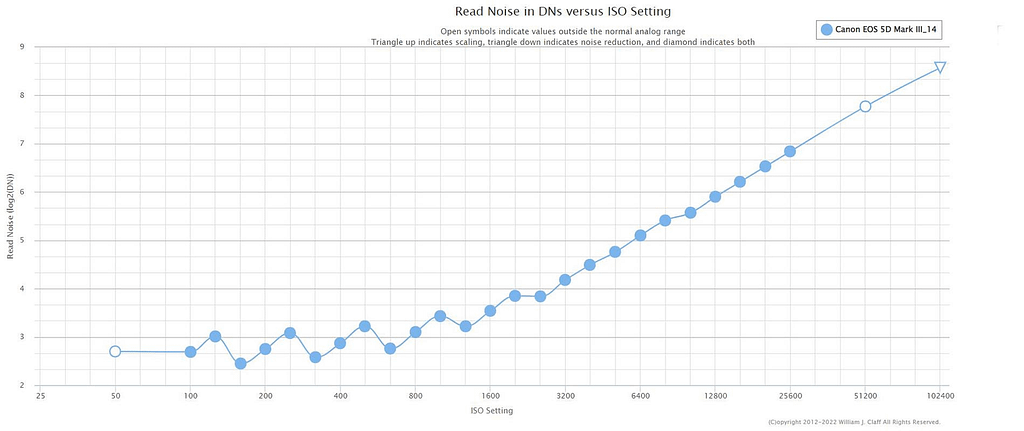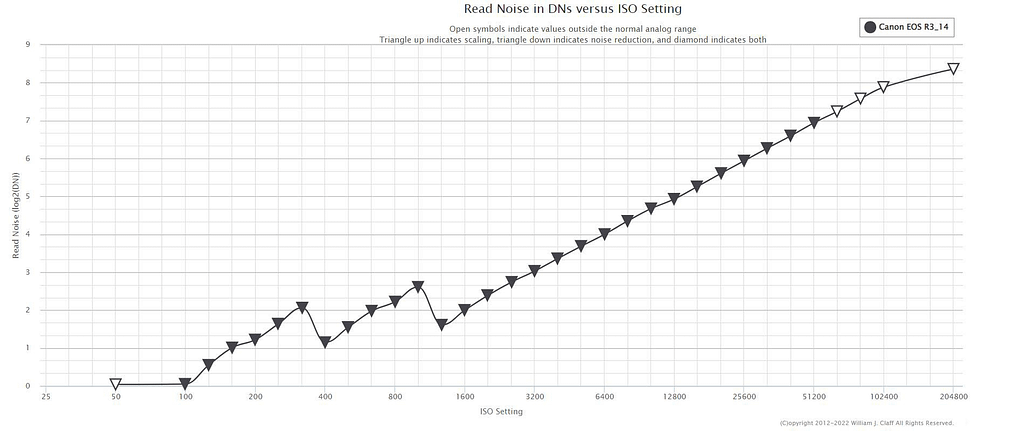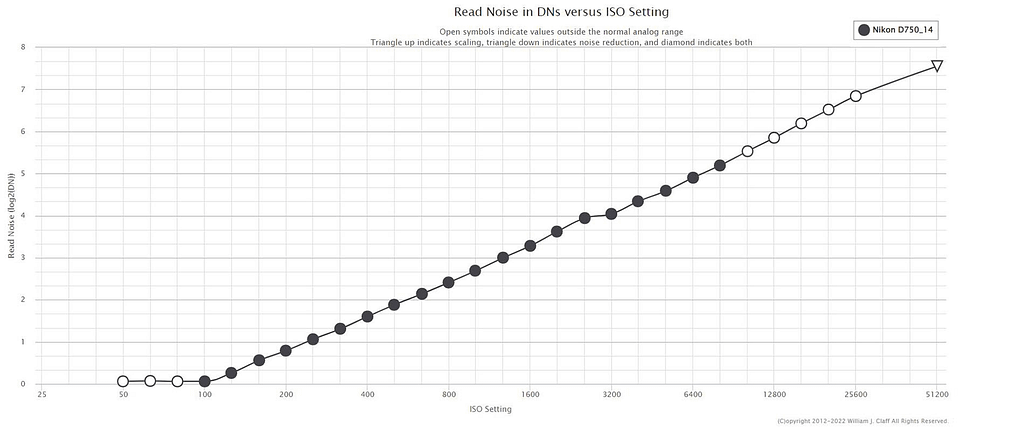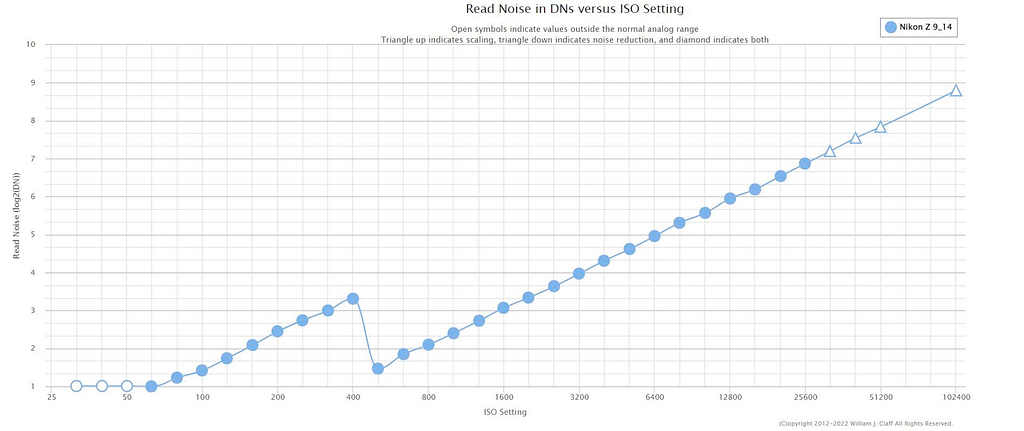How ISO Affects Noise In YOUR Camera
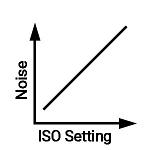
Most photographers don’t fully understand how ISO affects noise in their camera. That’s because most of us have been taught that we don’t really need to think that much about it. Specifically, we’ve all been taught that noise increases as you increase sensor sensitivity (or ISO) setting. The chart to the right, illustrates this perception. As a result, the “rule” has always been to use the lowest possible sensor sensitivity setting to minimize noise.
It’s a very simple rule and it is not camera specific. As a result, the only rule is to use the lowest possible sensor sensitivity that in balance with aperture and exposure time gives the desired exposure. There’s not a lot of thinking needed.
The Truth About ISO And Your Camera
It is true that, in general, noise does increase with ISO. But, only in general. And this gives us an opportunity to expand our options in selecting the best sensor sensitivity setting to minimize noise. Furthermore, the noise to ISO relationship varies by camera. If we really study the noise to ISO relationship for our specific camera, we can develop an ISO strategy that gives us the best options for reduced noise in our image even when shooting at a ISO setting above the base level.
Some of the truths we weren’t taught about noise and ISO are:
- This relationship varies by camera. Every camera, or more particularly, every sensor is different.
- It isn’t always a straight line* relationship. There may be peaks and valleys and the trend line may vary for segments over the ISO range.
- The ISO setting with the best (meaning lowest noise) performance is not necessarily the lowest or “base” ISO setting.
The Data
Fortunately, there is data supporting these “truths”. A little over a year ago I came across Photons to Photos website. At the time I thought it was interesting but it wasn’t until recently I took a closer look; I’m glad I did. William Claff has compiled a comprehensive amount of sensor data. It is an amazing body of work. Take a look and explore. For purposes of this discusses we will be using the “Read Noise in DNs Chart”.

Below are four sample charts that illustrate how the ISO affects noise can vary by camera. If you take a closer look at the chart for your particular camera you can gain some insights on how you may want to use this data for better noise performance. When reviewing these charts, it is important to note that the Y-Axis is logarithmic (base 2) which means that each whole number line represents a doubling of noise from the prior value. A “2” has twice the noise as a “1”; a “3” has twice the noise as a “2” and 4 times the noise as a “1”.
Sample Read Noise In DNs versus ISO Setting Charts
(Click on individual chart to see original on Photons to Photos )
These 4 cameras have characteristics that I saw in various combinations in most cameras. Some observations we can draw about how ISO affects noise are:
- Canon 5D Mk III – There are two interesting observations for the 5D3. First, over the range of 100 – 800 ISO (a 3-stop range) the relationship is relatively flat. Second, the ISO setting with the lowest noise is not the base 100 but rather an ISO of 160. At this higher setting I actually get 15% less noise.
- Canon R3 – This camera has a saw tooth pattern at the beginning. The first tooth indicates that ISO 160 and ISO 400 have nearly the same noise while values in between have higher noise levels. Similarly, on the second tooth ISO 500 and 1250 have about the same values with higher noise levels for ISO values in between.
- Nikon D750 – Interestingly the chart for this camera is basically the straight line we’ve always implicitly assumed and for the D750 it does mean the lower the ISO, the lower the noise.
- Nikon Z9 – The Z9 has a single “tooth” with an ISO of 100 and 500 having about the same noise. In addition, ISO 400 has 3.6 times the noise of ISO 500!
Applying This Information
So that now that we have this information what do we do with it. Let’s take a look at the information for the Canon 5D Mk III which happens to be the camera I use.
In regards to the relatively flat relationship between ISO 100 and 800, it means I can shoot anywhere in that range and not be overly concerned with my ISO setting. This is a 3-stop range so it gives me a lot of flexibility in choosing my ISO setting.
The second point is especially interesting. As result, I’ve started using 160 as my default ISO setting to get the best possible noise performance as a starting point. The necessary changes in aperture and exposure time aren’t dramatic and usually easily addressed.
Mountain Or Molehill?
At first glance these findings sound rather dramatic and very significant. However, after some thought you might wonder; am I making a mountain out of molehill? That’s an understandable question. The truth is that applying this data as I’ve suggested will make improvements in noise performance. However, they may not be dramatic or momentous changes; often the improvement may be barely discernable.
I mentioned earlier that by changing from ISO 100 to ISO 160 that I would get a 15% reduction in noise. Fifteen percent is a good improvement. The reason we don’t see much change is that reducing an already small number by 15% doesn’t make a significant change in practical terms. I did an experiment taking photos at both ISO settings and adjusting the exposure time to give equal exposure values. “Pixel peeping” at 100% magnification did show that ISO 160 did have better noise performance. However, in many practical cases this improvement may be only barely discernable, if at all.
So Why Do I Recommend This?
I believe that we should do everything we possibly can do from a technical standpoint to take a great photo. This includes understanding how ISO affects noise for my specific camera. I want my images to be judged based on my composition and processing skills rather than the technical aspect of how I took the photo. This means doing all the little things right, all the time. This includes even the ones that don’t have a lot of impact. A lot of actions that are individually insignificant can collectively make a difference.
The second reason comes down to “Why not? What have I got to lose?” Changing ISO from 100 to 160 or being aware of the range I’m shooting in doesn’t cause any insignificant issues. Yes, I have to change other settings but I do that all the time. But, that’s just part of taking a photo. It’s just not a big deal.
In the end I believe it won’t hurt; it might help; it doesn’t “cost” anything to do; so, why not? Just do it!
* Note that “straight line refers to the plot of the log2 value of the noise
Leave A Comment And Share
How do you think about ISO in terms of noise performance? I’d love to hear your comments and feedback. Please leave a comment in the comment box below.
Also, if you like this post please share on Facebook and Twitter.


